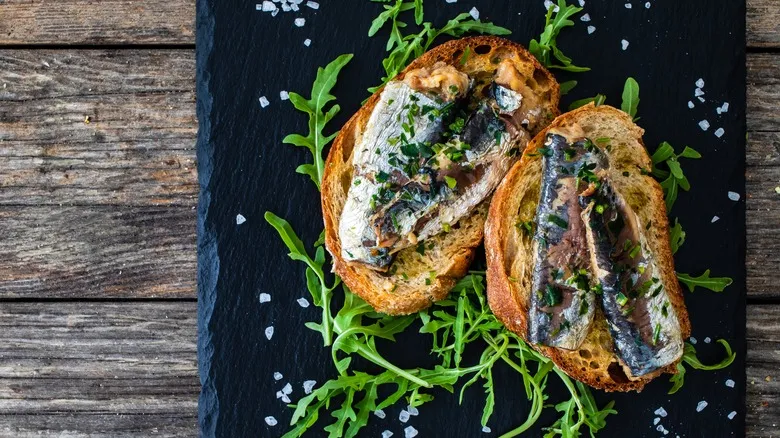How to serve canned sardines

Consider the size of the sardines you choose, as noted by Maccubbin. "Opt for small sardines if you prefer a more delicate texture and flavor. Regular sardines are meatier and can hold up to bolder condiments or light cooking." Small sardines are ideal for enjoying on their own or with simple sides like bread. Maccubbin advocates for a straightforward approach when serving tinned sardines. "We usually serve them straight from the can. Tinned seafood is generally already cooked and/or cured, so there's no need to complicate things."
He recommends layering them on crostini, although at Maiden Lane, sardines are often accompanied by additional condiments. "We serve everything from the tin with baguette, quality soft butter, sea salt, and a parsley salad. A squeeze of lemon or a mild hot sauce is always a nice touch. Aioli and pickled onions also make great additions if you're serving them on crostini or crackers."
Maiden Lane offers several brands, including Ramón Peña, a Spanish company known for its sardines that are celebrated for their mild yet distinctive flavor, perfectly balanced with the olive oil in the can. They also carry Jacques Gonidec brand sardines from France, available in varieties marinated in lemon, chile, or simply olive oil. The chile-marinated sardines are noted for their pleasant kick while still allowing the fish's flavor and texture to shine.
Using canned sardines in recipes

Maccubbin typically prefers to serve sardines with minimal accompaniments, often enjoying them straight from the can alongside the previously mentioned sides. However, he points out that canned seafood can also enhance dishes when added at the end of cooking. "I like to toss clams in at the last moment in a linguini with white wine or top simple garlic bread with smoked mussels. Smoked trout pairs wonderfully with eggs, but be cautious not to overcook it," he advises. For sardines, Maccubbin's favorite suggestion is to place them atop a lightly dressed salad. The salad can vary; sardines complement both bean salads and tomato salads equally well.
Pasta is another excellent vehicle for sardines. Even if Maccubbin chooses clams for his linguini, there are plenty of recipes that treat sardines similarly. One option is Sicilian-style pasta featuring white wine spaghetti and fennel. Other recipes keep it straightforward; for instance, spaghetti with lemon and chiles can be elevated with the addition of sardines for a salty, fishy flavor. Alternatively, sardines on toast topped with your choice of ingredients (like marinated vegetables or avocado) is a timeless classic.
Regardless of how you prepare them, ensure that the sardines can take center stage. High-quality canned sardines can easily cost over $10 (often for a small can), so you won’t want to use too many and risk overshadowing their flavor with excessive competing ingredients.
Recommended

What To Do If You Don't Have A Vacuum Seal For Your Sous Vide

The Popular Caramelized Onion Shortcut You Shouldn't Use

11 Tips To Make Your Caesar Salad Taste Like It Came From A Restaurant

The Correct Way To Cook A Potato In The Microwave Couldn't Be Easier
Next up

